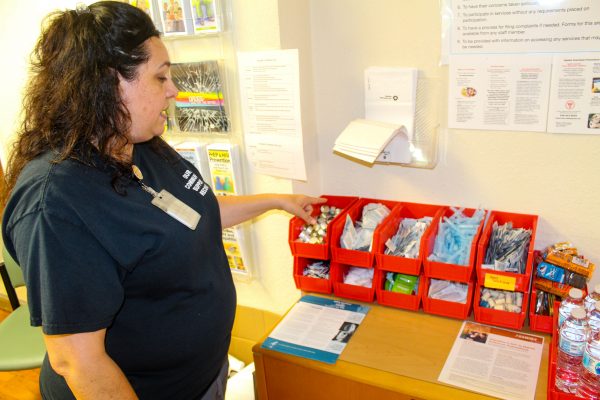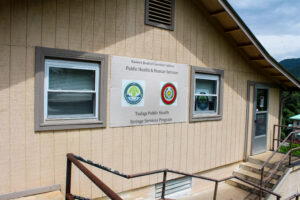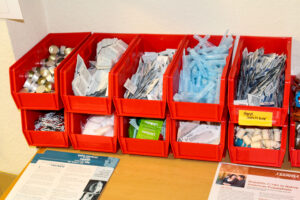
DEDICATION: Ginger Parker-Southard, Syringe Services Program supervisor, shows some of the supplies they provide for free through their program – all in an effort to curb the transmission of HIV and Hep C. (SCOTT MCKIE B.P./One Feather photos)
By SCOTT MCKIE B.P.
ONE FEATHER STAFF
Several years ago, tribal officials declared an epidemic level of Hepatitis C (Hep C) in the Cherokee community. Now, staff at a small, yellow building overlooking the EBCI Public Health and Human Services administration building is working diligently to help curb that dilemma.
The Tsalagi Public Health Syringe Services Program was approved by Tribal Council a year ago and opened its doors on Feb. 1. There are currently 266 people enrolled in the anonymous program.
Vickie Bradley, EBCI Secretary of Public Health and Human Services, said the main goal of the program is harm reduction. “We have an epidemic of Hep C in this community, and ultimately the goal of the Syringe Services Program is to reduce incidences or new cases of Hep C. But, more than that, people who use syringe services programs are twice as likely to get into treatment and there are 60 percent less syringes on the street and less needle sticks to EMS personnel and other first responders. So, our overall goal is to reduce disease, but it’s also to instill hope and connect people with services.”
Information from the North Carolina Harm Reduction Council states, “Decades of research shows that syringe exchange programs are effective at lowering rates of HIV and hepatitis C, connecting drug users to treatment, preventing deaths from drug overdose, and offering a range of health and supportive services, including referrals to programs for food, housing, and employment.”
First-time clients to the Tsalagi Public Health Syringe Services Program receive syringes and other supplies for safer injection of their drugs. “We give out cookers, alcohol, cotton pellets to filter it through, sterile water, tourniquets, band-aids, anti-bacterial ointment, hand sanitizer, and paper clips to hold the cooker with so they don’t get burned,” said Ginger Parker-Southard, Syringe Services Program supervisor. “They can come in and get as much of that as they need so they’re not re-using any of it. The CDC says that Hep C can live on a surface for up to 30 days even if you don’t see any blood.”

HARM REDUCTION: The Tsalagi Public Health Syringe Services Program is located at 73 Kaiser Wilnoty Drive in Cherokee. Currently, the Syringe Services Program is open Monday (11am -5:30pm), Thursday (11am – 3pm), and Friday (11am – 5:30pm). Starting on Sept. 1, the Program will have the following new hours: Monday (9am – 5pm), Tuesday (9am – 5pm), Thursday (9:30am – 6pm), and Friday (9:30am – 6pm).
The clients are issued a program identification card that contains only a number unique to them. They are encouraged to bring back syringes in order to receive more. Parker-Southard said that the average user will inject 10 to 15 times daily. “We try to give them enough to get through until the next visit to our site. Most people come once or twice a week. The maximum amount that we ever give out is 100 per visit.”
If clients return without any used syringes, they only receive 10. “We use that as an incentive to get more back and out of the community.”
That incentive is working.
“Our return rate has increased,” said Parker-Southard. “Last week, it was 52.4 percent and the week before it was 51.3 percent. Our goal is 50 percent, and that’s really more than any of the syringe services in the state get back.”
Secretary Bradley said, “The goal of syringe services programs is to get your syringe rate of return up. We actually had one day that it was 102 percent. It’s gone up exponentially. It started out around 12 to 15 percent the first month. So, in about six months, we’re running at around 50 percent the last few weeks, and overall, we’re at about 41 percent from the time that we started.”
The program also provides clients with education in addition to providing syringes and other supplies. “We educate them on how to clean their (injection) sites,” said Parker-Southard. “We educate them on how to look to see if they have any signs of infection at their injection site. We educate them on how Hep C is spread because it’s not just with the needles. It can be spread with a toothbrush, a razor…we just educate people to make sure they’re doing the best they can not to spread that to anybody else.”
She said the Syringe Services Program has a “great” relationship with Analenisgi, and they make sure that clients are aware of the services provided there. A peer support specialist comes to the program twice a week, “She’s there to talk to anybody who has questions about getting into group or getting into recovery,” noted Parker-Southard. “We help them in any way that we can help.”
Secretary Bradley said the program also does refer for HIV and Hep C testing as well as pregnancy testing. “If they are pregnant, then Ginger does all that she can to get them connected into pre-natal treatment…our goal is to keep that baby and mother united, and if she can understand that we’re not judging her and that she has potential for not getting her baby taken, then she’s likely to go to pre-natal care.”
Parker-Southard commented, “A lot of people think that if they go to get help that they’ll automatically lose their child. There are a lot of myths like that out there about our program. Some people still think that we report to the police which we do not, and they’re afraid about getting arrested.”

SUPPLIES: The Syringe Services Program provides many clean, sterile supplies including: syringes, cookers, alcohol pads, sterile water, cotton pellets, and more.
Secretary Bradley said she expects the program to continue to grow, “I think if we mobilize our action for an opioid response within our community and people feel safe, that they are not judged, that there are resources there and that we just want them to be healthier, we will begin to get more people.”
The program sees anywhere from 20 to 30 people daily now; a number that is up from an average of 10 when it started in February.
Secretary Bradley said the program is also going to grow in other ways. She recently submitted grants to the CDC and North Carolina Public Health and Human Services seeking contract personnel to do syringe litter pick-up in the community and to help reimburse the costs of installing 20 kiosks in the community for syringe disposal. “There will be one in each community and then in strategic places around the Boundary. We will manage that syringe pick-up.”
She noted that the tamper-proof kiosks, which will be mounted into the ground on concrete, will be installed within the next 90 days. “These are in a lot of cities, California is big on these. Diabetics can use them, anyone with any kind of syringe can use them.”
The program also distributes free injectable Narcan kits. “Fortunately, North Carolina Harm Reduction Coalition has given us all of our doses of Narcan. It hasn’t cost the program anything. Seven hundred and eight (708) doses have been dispensed and 65 reversals have been reported, and we started dispensing on April 6.”
Currently, the Syringe Services Program is open Monday (11am -5:30pm), Thursday (11am – 3pm), and Friday (11am – 5:30pm). Starting on Sept. 1, the Program will have the following new hours: Monday (9am – 5pm), Tuesday (9am – 5pm), Thursday (9:30am – 6pm), and Friday (9:30am – 6pm).
Tsalagi Public Health lists symptoms for the following diseases and ailments:
HIV: initial exposure to the virus may cause flu-like symptoms, skin problems such as rash or sensitivity to light; swollen lymph nodes, low-grade fever that doesn’t go away, and night sweats
Hep C: flu-like symptoms, very darkly colored urine, skin or the whites of the eyes appear yellow, stomach pain, nausea and vomiting
Wound Infection/Abscess: redness around injection site, swelling around injection site, skin feels hot or pain around injection site, fever, or drainage around the injection site
Info: Tsalagi Public Health Syringe Services Program, 73 Kaiser Wilnoty Drive, Cherokee, 359-6879




